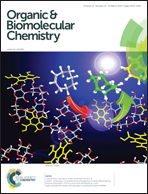Tuning temperature responsive poly(2-alkyl-2-oxazoline)s by supramolecular host–guest interactions†
Abstract
A poly[(2-ethyl-2-oxazoline)-ran-(2-nonyl-2-oxazoline)] random copolymer was synthesized and its thermoresponsive behavior in aqueous solution modulated by the addition of different supramolecular host molecules. The macrocycles formed inclusion complexes with the nonyl aliphatic side-chains present in the copolymer, increasing its cloud point temperature. The extent of this temperature shift was found to depend on the cavitand concentration and on the strength of the host–guest complexation. The cloud point temperature could be tuned in an unprecedented wide range of 30 K by supramolecular interactions. Since the temperature-induced breakage of the inclusion complexes constitutes the driving force for the copolymer phase transition, the shift in cloud point temperature could be utilized to estimate the association constant of the nonyl side chains with the cavitands.

- This article is part of the themed collection: Supramolecular Chemistry in Water

 Please wait while we load your content...
Please wait while we load your content...